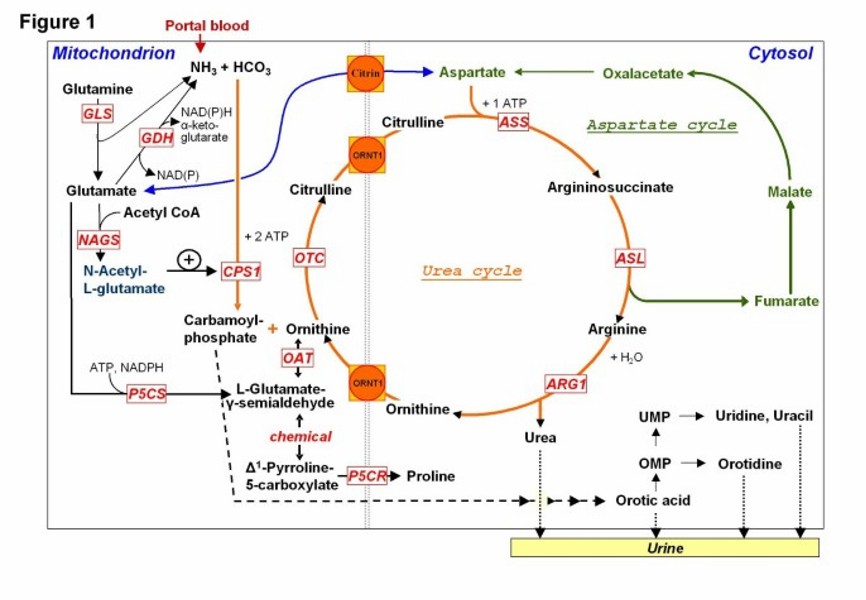Urea Cycle Disorder (UCD) Research Services
Current research pain points in urea cycle disorders (UCD) center on the complexity of the etiology, difficulties in diagnosis, limitations in treatments, uncertainty in long-term prognosis, and the challenges of gene therapy. Protheragen, a rare disease research service provider, is dedicated to helping researchers explore UCD pathomechanisms in greater depth and develop more effective diagnostics and therapies.
What Is Urea Cycle Disorder?
Urea cycle disorders are rare genetic disorders in which ammonia accumulates in the body primarily due to defects in six enzymes in the urea cycle pathway (e.g., CPS1, OTC, ASL, etc.), leading to hyperammonemia and related health problems.
 Figure 1. The urea cycle and associated pathways. (Häberle J, et al.,2012)
Figure 1. The urea cycle and associated pathways. (Häberle J, et al.,2012)Age of Onset of Urea Cycle Disorders
- Neonatal or infancy
- Childhood, adolescence and adulthood
In the neonatal period, urea cycle disorders often present as an acute metabolic crisis caused by hyperammonemia. In adulthood, urea dyscrasia is usually characterized by acute or chronic hyperammonemia and may even lead to encephalopathy, seizures and liver dysfunction. The age of onset of urea cycle disorders is closely related to residual enzyme activity, the degree of metabolic disruption and the causative factors.
Therapies for Urea Cycle Disorders
- Dietary management
- Pharmacotherapies that specifically target ammonia
- Liver transplantation
- Gene therapy
- Liver-derived mesenchymal stem cell therapy
- Gut flora therapy
Disclaimer: Protheragen specializes in providing preclinical research services. The above is for informational purposes only. For guidance on treatment options, please visit the regular hospital.
Our Services
Model Development Services for Urea Cycle Disorders
In Vitro Models
- Human induced pluripotent stem cells (iPSCs)
- Hepatocyte-like cells
- Opti-HEP model
In Vivo Models
- Conditional late-onset arginase 1 deficiency mouse model
- Ornithine transcarbamylase deficiency (OTCD) mouse model
- Arginase 2-deficient mouse model
- Liver-humanized mouse model
- OTCD pig model
Our in vitro models each have the advantage of simulating the pathophysiological process of urea cycle disorders from different perspectives. Our in vivo model allows us to help researchers unravel the pathomechanisms of urea cycle disorders and also provides an important platform for the development of new therapeutic approaches.
Pathophysiologic Analysis of Urea Cycle Disorders
The analysis we support includes:
- The basic processes of the urea cycle
- Enzyme defects leading to impaired urea cycling
- Toxic effects of ammonia
- Effects of other metabolic pathways
The above analysis may help researchers to gain a deeper understanding of hepatic metabolic function and its importance in systemic nitrogen metabolism.
Therapy Development Services for Urea Cycle Disorders
The types of therapeutic development we support:
- Gene therapy
- Enzyme replacement therapy
- Stem cell therapy
- Small molecule drug
Our extensive research experience allows us to help investigators improve the safety and efficacy of existing therapies or develop new, more targeted therapies.
We can customize solutions and analytical processes according to your different research needs and track project progress in real time to accelerate your scientific discoveries. If you are interested in our services, please contact us for more details.
Reference
- Häberle J, Boddaert N, Burlina A, et al. Suggested guidelines for the diagnosis and management of urea cycle disorders. Orphanet J Rare Dis. 2012; 7:32.
All of our services and products are intended for preclinical research use only and cannot be used to diagnose, treat or manage patients.
